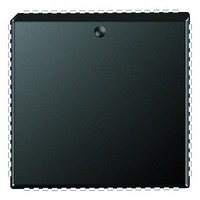PIC18F6585-I/L Microchip Technology, PIC18F6585-I/L Datasheet - Page 59

PIC18F6585-I/L
Manufacturer Part Number
PIC18F6585-I/L
Description
Microcontrollers (MCU) 48KB 3328 RAM 52 I/O
Manufacturer
Microchip Technology
Datasheet
1.PCM18XK1.pdf
(496 pages)
Specifications of PIC18F6585-I/L
Processor Series
PIC18F
Core
PIC
Data Bus Width
8 bit
Data Ram Size
3.25 KB
Interface Type
I2C/SPI/AUSART/CAN
Maximum Clock Frequency
40 MHz
Number Of Programmable I/os
53
Number Of Timers
5
Maximum Operating Temperature
+ 85 C
Mounting Style
SMD/SMT
3rd Party Development Tools
52715-96, 52716-328, 52717-734, 52712-325, EWPIC18
Development Tools By Supplier
PG164130, DV164035, DV244005, DV164005, PG164120, ICE2000, ICE4000, DV164136, DM183032
Minimum Operating Temperature
- 40 C
On-chip Adc
12-ch x 10-bit
Program Memory Type
Flash
Program Memory Size
48 KB
Package / Case
PLCC-68
Lead Free Status / RoHS Status
Lead free / RoHS Compliant
- Current page: 59 of 496
- Download datasheet (9Mb)
4.6
An “Instruction Cycle” consists of four Q cycles (Q1,
Q2, Q3 and Q4). The instruction fetch and execute are
pipelined such that fetch takes one instruction cycle,
while decode and execute takes another instruction
cycle. However, due to the pipelining each instruction
effectively executes in one cycle. If an instruction
causes the program counter to change (e.g., GOTO),
then two cycles are required to complete the instruction
(Example 4-2).
EXAMPLE 4-2:
4.7
The program memory is addressed in bytes. Instruc-
tions are stored as two bytes or four bytes in program
memory. The Least Significant Byte (LSB) of an
instruction word is always stored in a program memory
location with an even address (LSB = 0). Figure 4-6
shows an example of how instruction words are stored
in the program memory. To maintain alignment with
instruction boundaries, the PC increments in steps of 2
and the LSB will always read ‘0’ (see Section 4.4
“PCL, PCLATH and PCLATU”).
FIGURE 4-6:
2004 Microchip Technology Inc.
1. MOVLW 55h
2. MOVWF PORTB
3. BRA
4. BSF
5. Instruction @ address SUB_1
All instructions are single cycle except for any program branches. These take two cycles since the fetch instruction
is “flushed” from the pipeline while the new instruction is being fetched and then executed.
Instruction Flow/Pipelining
Instructions in Program Memory
SUB_1
PORTA, 3 (Forced NOP)
Instruction 1:
Instruction 2:
Instruction 3:
INSTRUCTION PIPELINE FLOW
INSTRUCTIONS IN PROGRAM MEMORY
Program Memory
Byte Locations
MOVLW
GOTO
MOVFF
Fetch 1
T
CY
0
055h
000006h
123h, 456h
Execute 1
Fetch 2
PIC18F6585/8585/6680/8680
T
CY
1
Execute 2
Fetch 3
LSB = 1
T
0EFh
0F0h
0C1h
0F4h
CY
0Fh
2
A fetch cycle begins with the program counter (PC)
incrementing in Q1.
In the execution cycle, the fetched instruction is latched
into the “Instruction Register” (IR) in cycle Q1. This
instruction is then decoded and executed during the
Q2, Q3, and Q4 cycles. Data memory is read during Q2
(operand read) and written during Q4 (destination
write).
The CALL and GOTO instructions have an absolute pro-
gram memory address embedded into the instruction.
Since instructions are always stored on word bound-
aries, the data contained in the instruction is a word
address. The word address is written to PC<20:1>
which accesses the desired byte address in program
memory. Instruction #2 in Figure 4-6 shows how the
instruction “GOTO 000006h” is encoded in the program
memory. Program branch instructions which encode a
relative address offset operate in the same manner.
The offset value stored in a branch instruction repre-
sents the number of single-word instructions that the
PC will be offset by. Section 25.0 “Instruction Set
Summary” provides further details of the instruction
set.
Execute 3
Fetch 4
LSB = 0
T
CY
55h
03h
00h
23h
56h
3
Fetch SUB_1 Execute SUB_1
Flush (NOP)
Word Address
000000h
000002h
000004h
000006h
000008h
00000Ah
00000Ch
00000Eh
000010h
000012h
000014h
T
CY
4
DS30491C-page 57
T
CY
5
Related parts for PIC18F6585-I/L
Image
Part Number
Description
Manufacturer
Datasheet
Request
R

Part Number:
Description:
20-Pin USB Flash Microcontrollers
Manufacturer:
MICROCHIP [Microchip Technology]
Datasheet:

Part Number:
Description:
PIC18F With 128-segment LCD Driver And 12-bit ADC, 8KB Flash, 768B RAM, CCP, MSS
Manufacturer:
Microchip Technology
Datasheet:

Part Number:
Description:
PIC18F With 128-segment LCD Driver And 12-bit ADC, 16KB Flash, 768B RAM, CCP, MS
Manufacturer:
Microchip Technology
Datasheet:

Part Number:
Description:
PIC18F With 192-segment LCD Driver And 12-bit ADC, 8KB Flash, 768B RAM, CCP, MSS
Manufacturer:
Microchip Technology
Datasheet:

Part Number:
Description:
PIC18F With 192-segment LCD Driver And 12-bit ADC, 16KB Flash, 768B RAM, CCP, MS
Manufacturer:
Microchip Technology
Datasheet:

Part Number:
Description:
Microcontrollers (MCU) 64KB 3328 RAM 52 I/O
Manufacturer:
Microchip Technology
Datasheet:

Part Number:
Description:
32kB Flash, 2kB RAM, 1kB EE, NanoWatt XLP, LCD 64 QFN 9x9x0.9mm T/R
Manufacturer:
Microchip Technology
Datasheet:

Part Number:
Description:
32kB Flash, 2kB RAM, 1kB EE, NanoWatt XLP, LCD 64 TQFP 10x10x1mm T/R
Manufacturer:
Microchip Technology
Datasheet:

Part Number:
Description:
128kB Flash, 4kB RAM, 1kB EE, 16MIPS, NanoWatt XLP, LCD, 5V 80 TQFP 12x12x1mm T/
Manufacturer:
Microchip Technology
Datasheet:

Part Number:
Description:
32kB Flash, 2kB RAM, 1kB EE, NanoWatt XLP, LCD 64 QFN 9x9x0.9mm TUBE
Manufacturer:
Microchip Technology
Datasheet:

Part Number:
Description:
32kB Flash, 2kB RAM, 1kB EE, NanoWatt XLP, LCD 64 TQFP 10x10x1mm TRAY
Manufacturer:
Microchip Technology

Part Number:
Description:
128kB Flash, 4kB RAM, 1kB EE, 16MIPS, NanoWatt XLP, LCD, 5V 80 TQFP 12x12x1mm TR
Manufacturer:
Microchip Technology

Part Number:
Description:
Manufacturer:
Microchip Technology Inc.
Datasheet:










